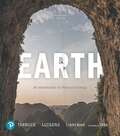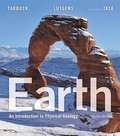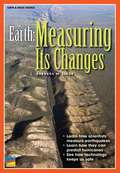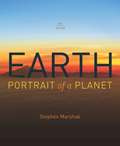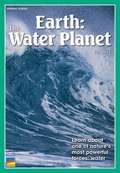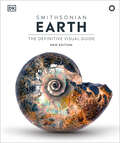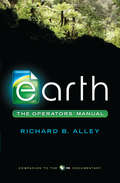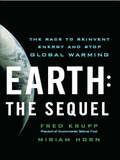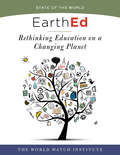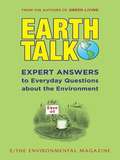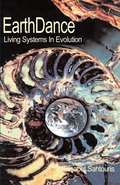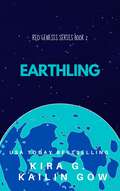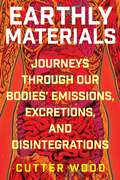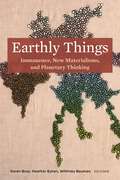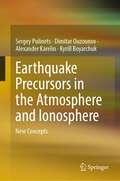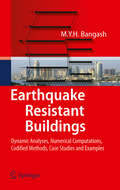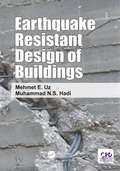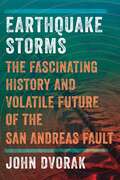- Table View
- List View
Earth: An Introduction to Physical Geology
by Edward J. Tarbuck Dennis G. Tasa Frederick K Lutgens Scott LinnemanBringing Earth to life Earth: An Introduction to Physical Geology, 13th Edition, is a leading text in the field, characterized by no-nonsense, student-friendly writing, excellent illustrations, and a modular learning path driven by learning objectives. The new edition is the first to integrate 3D technology that brings geology to life. This edition features significant content updates, a new Geology in the News feature to promote student engagement, and a new Data Analysis feature to help develop students’ critical thinking skills.
Earth: An Introduction to Physical Geology
by Dennis Tasa Edward Tarbuck Frederick LutgensWith its strong readability and engaging, instructive illustrations, this trusted bestseller returns with a hybrid and streamlined focus on core principles. Earth: An Introduction to Physical Geology maintains a learning objective-driven approach throughout each chapter: The text provides readers with a structured learning path, tied to learning objectives with opportunities for readers to demonstrate their understanding at the end of each section. The authors’ emphasis on currency and relevance includes the latest thinking in the field, particularly in the dynamic area of plate tectonics.
Earth: Measuring Its Changes
by Margaret Mcnamara Barbara M. LindeFind out about the ways scientists measure how water, wind, earthquakes, and glaciers change our Earth.
Earth: Portrait of a Planet
by Stephen MarshakThis new edition will only enhance its success. It has been thoroughly revised to ensure current coverage of all major topics, especially earthquakes (including the disaster in Haiti in 2010), volcanoes, and climate change. The drawn art represents the state of the art and is both pedagogically innovative and a feast for the eyes. The Google Earth exercises provide virtual field trips to the entire world.
Earth: The Definitive Visual Guide, New Edition (DK Definitive Visual Encyclopedias)
by DKExplore and understand the natural and human wonders of our planetNow in its third edition, this landmark encyclopedia both celebrates our planet and explains the science underpinning the forces and processes that have made and shaped it. Artworks, photographs, terrain models, and maps are used in combination to capture the beauty and power of landscapes and natural events and to show their hidden sides, explaining for example how an earthquake is triggered and how burning fossil fuels is driving a climate emergency.Directory sections placed throughout the book provide systematic and in-depth reference guides to core scientific information, such as more than 100 types of rocks and minerals. Similar sections contain visual profiles of some of the undisputed wonders of the natural world, from the Andes and Himalayas to the Grand Canyon, Sahara Desert, and Amazon Rainforest.Thoroughly revised and updated to include new and spectacular landscape photography and capture the latest developments in fast-changing areas of geology and Earth science—including Earth history, climate change, and urban geography—this is an indispensable visual reference book for anyone who wants to understand how our planet works.
Earth: The Operators' Manual
by Richard B. AlleyThe book--companion to a PBS series--that proves humans are causing global warming and offers a path to the future. Since the discovery of fire, humans have been energy users and always will be. And this is a good thing-our mastery of energy is what separates us from the rest of the animal kingdom and has allowed us to be the dominant species on the planet. However, this mastery comes with a price: we are changing our environment in a profoundly negative way by heating it up. Using one engaging story after another, coupled with accessible scientific facts, world authority Richard B. Alley explores the fascinating history of energy use by humans over the centuries, gives a doubt-destroying proof that already-high levels of carbon dioxide are causing damaging global warming, and surveys the alternative energy options that are available to exploit right now. These new energy sources might well be the engines for economic growth in the twenty-first century.
Earth: The Race to Reinvent Energy and Stop Global Warming
by Fred Krupp Miriam HornHow to harness the great forces of capitalism to save the world from catastrophe. The forecasts are grim and time is running out, but that's not the end of the story. In this book, Fred Krupp, longtime president of Environmental Defense Fund, brings a surprisingly hopeful message: We can solve global warming. And in doing so, we will build the new industries, jobs, and fortunes of the twenty-first century.In these pages the reader will encounter the bold innovators and investors who are reinventing energy and the ways we use it. These entrepreneurs are poised to remake the world's biggest business and save the planet--if America's political leaders give them a fair chance to compete.
Earth: The Shocking Truth Behind the Greatest Cover-Up in Human History
by Timothy GoodThis fascinating new volume tells the story of contact between aliens and humans from all across the globe, dating back to 1932, including meetings with military personnel and American presidents such as Eisenhower and Kennedy.For the first time, a former member of MI6 reveals her conversation with Neil Armstrong at a NASA conference, when she confirmed that there were "other" spacecraft on the moon when Apollo 11 landed in 1969. Armstrong also confirmed that the CIA was behind the cover-up.In a further admission in December 2012, Russian Prime Minister Dmitry Medvedev revealed "the president of Russia is given a special top secret folder [that] in its entirety contains information about aliens who have visited our planet. Along with this, the president is given a report of the Special Service that exercises control over aliens in our country. I will not tell you how many of them are among us because it may cause panic."
EarthComm Earth System Science in the Community
by Michael J. Smith John B. Southard Ruta DemeryImagine more than 500,000 Earth scientists worldwide sharing a common voice, and you've just imagined the mission of the American Geological Institute. Our mission is to raise public awareness of the Earth sciences and the role that they play in mankind's use of natural resources, mitigation of natural hazards, and stewardship of the environment.
EarthComm Project-Based Space and Earth System Science
by Ann Benbow Mark Carpenter Matthew Hoover Michael J. Smith [et al.]EarthComm is an inclusive book on the community that human beings live in, their surrounding; the earth and space, and the interaction among the living things, air, th waters and land, and how each existance affects the survival of the other. Collated with special specs to outlay the information in an exciting and fun way to learn and retain the knowledge intended
EarthEd: Rethinking Education on a Changing Planet (State of the World)
by The Worldwatch InstituteEarth education is traditionally confined to specific topics: ecoliteracy, outdoor education, environmental science. But in the coming century, on track to be the warmest in human history, every aspect of human life will be affected by our changing planet. Emerging diseases, food shortages, drought, and waterlogged cities are just some of the unprecedented challenges that today's students will face. How do we prepare 9.5 billion people for life in the Anthropocene, to thrive in this uncharted and more chaotic future?Answers are being developed in universities, preschools, professional schools, and even prisons around the world. In the latest volume of State of the World, a diverse group of education experts share innovative approaches to teaching and learning in a new era. Topics include systems thinking for kids; the importance of play in early education; social emotional learning; comprehensive sexuality education; indigenous knowledge; sustainable business; medical training to treat the whole person; teaching law in the Anthropocene; and more.EarthEd addresses schooling at all levels of development, from preschool to professional. Its lessons can inform teachers, policy makers, school administrators, community leaders, parents, and students alike. And its vision will inspire anyone who wants to prepare students not only for the storms ahead but to become the next generation of sustainability leaders.
EarthTalk: Expert Answers to Everyday Questions About the Environment
by E MagazineFrom the authors of the leading environmental handbook Green Living? the best of E?s nationally syndicated Q&A column, EarthTalk E / The Environmental Magazine has established itself as the leading independent environmental periodical since its debut in 1990. E reaches 180,000 readers per issue, and its website attracts up to 600,000 visitors a month. One of their most popular features is the column EarthTalk, now nationally syndicated in up to 1,700 newspapers, magazines, and websites. In EarthTalk, the editors of E answer readers? questions on the environment and the best ways to live green. EarthTalk gathers together the best of these questions and answers in a quick and easy guide for the average Joe (or Jane). Searching by subject or looking up questions in the index, readers can learn everything from the difference between wild and farmed salmon to the pros and cons of nuclear power. EarthTalk provides the essential tools and tips to living in harmony with the planet.
Earthcomm: Earth System Science in the Community (5 Unit Student Edition)
by Michael J. Smith John B. Southard Ruta DemeryDiscover the wonder and importance of Earth science by studying it where it counts--in your community.
Earthcomm: Earth's Fluid Spheres
by Michael J. Smith John B. Southard Ruta DemeryBy reading EarthComm classroom, you'll discover the wonder and importance of Earth science by studying it where it counts--in your community.
Earthcomm: Earth's Natural Resources
by Michael J. Smith John B. Southard Ruta DemeryBy studying EarthComm one will discover the wonder and importance of Earth science.
Earthling (Red Genesis #2)
by Kailin Gow Kira G.Book 2 of the Red Genesis Series... What if the last Earthlings on New Earth was worst than the Monsters who destroyed Old Earth? USA Today Bestselling and ALA YALSA Award-winning Authors Kira G. and Kailin Gow's Science Fiction Post-Apocalypse Thriller. If you liked Bird Box and The Quiet Place, you will enjoy RED GENESIS. Evie discovered she was not the only one left on New Earth, and that the other humans may be worst than the Monsters that destroyed Earth. As she tries to salvage what remains of the Red Genesis, she finds the answers to what may save Earth in something tied to her past. This is a STEM/ELA Literary Book for Age 14 and Up and includes STEM and ELA Literary Discussion Questions.
Earthly Materials: Journeys Through Our Bodies' Emissions, Excretions, and Disintegrations
by Cutter WoodAn “UNEXPECTEDLY PROFOUND,” “DEEPLY STRANGE,” and “UTTERLY UNIQUE tour of the human body” (Publishers Weekly)"A must read for anyone who’s ever been amazed or aghast at what just came out." — Rachel Yoder, author of NightbitchTo live, our bodies must continuously shed materials. Stop urinating, stop defecating, stop expelling breath, and death is near. While we often think of these materials as embarrassing waste products, they serve far more complex functions. The color of our mucus, the volume of our flatus, the rhythm of our breath: taken together, these materials tell a story of the human that produced them. Moreover, the exchange, elimination, and frequent disguise of our effluence has been elemental to the development of human civilization, and our lives today are still governed by a host of laws and superstitions and social mores about the materials our bodies leave behind.In each of twelve discrete chapters, Earthly Materials tells a story about one of the materials the human body sheds—from breath and urine to vomit and tears. Sometimes the questions examined are historical: What have we physically done with all the urine produced in our cities? Sometimes they approach the matter through a philosophical lens: Is it ever logical to cry? Sometimes they explore recent scientific discoveries: How is mucus forcing us to reconsider our understanding of natural selection? But they always offer a window into how we negotiate our place in the world and how we get along with one another. Cutter Wood's delightfully weird, richly informative, and unexpectedly poetic tour of our bodily excretions uncovers extraordinary truths about ourselves--and the human story.
Earthly Things: Immanence, New Materialisms, and Planetary Thinking
by Karen Bray, Heather Eaton, and Whitney BaumanGlobalization and climate weirding are two of the leading phenomena that challenge and change the way we need to think and act within the planetary community. Modern Western understandings of human beings, animals, and the rest of the natural world and the subsequent technologies built on those understandings have thrown us into an array of social and ecological crises with planetary implications. Earthly Things: Immanence, New Materialisms, and Planetary Thinking, argues that more immanent or planetary ways of thinking and acting have great potential for re-thinking human-technology-animal-Earth relationships and for addressing problems of global climate weirding and other forms of ecological degradation. Older and often-marginalized forms of thought from animisms, shamanisms, and other religious traditions are joined by more recent forms of thinking with immanence such as the universe story, process thought, emergence theory, the new materialisms (NM’s), object-oriented ontologies (OOO’s), affect theory, and queer theory.This book maps out some of the connections and differences between immanent frameworks to provide some eco-intellectual commons for thinking within the planetary community, with a particular emphasis on making connections between more recent theories and older ideas of immanence found in many of the world’s religious traditions. The authors in this volume met and worked together over five years, so the resulting volume reveals sustained and multifaceted perspectives on “thinking and acting with the planet.”
Earthquake Engineering and Structural Dynamics in Memory of Ragnar Sigbjörnsson
by Rajesh Rupakhety Símon ÓlafssonThis book presents methods and results that cover and extend beyond the state-of-the-art in structural dynamics and earthquake engineering. Most of the chapters are based on the keynote lectures at the International Conference in Earthquake Engineering and Structural Dynamics (ICESD), held in Reykjavik, Iceland, on June 12-14, 2017. The conference is being organised in memory of late Professor Ragnar Sigbjörnsson, who was an influential teacher and one of the leading researchers in the fields of structural mechanics, random fields, engineering seismology and earthquake engineering. Professor Sigbjörnsson had a close research collaboration with the Norwegian Institute of Science and Technology (NTNU), where his research was mainly focused in dynamics of marine and offshore structures. His research in Iceland was mainly focused on engineering seismology and earthquake engineering. The keynote-lecture based chapters are contributed by leading experts in these fields of research and showcase not only the historical perspective but also the most recent developments as well as a glimpse into the future. These chapters showcase a synergy of the fields of structural dynamics, engineering seismology, and earthquake engineering. In addition, some chapters in the book are based on works carried out under the leadership and initiative of Professor Sigbjörnsson and showcase his contribution to the understanding of seismic hazard and risk in Iceland. As such, the book is useful for both researchers and practicing engineers who are interested in recent research advances in structural dynamics and earthquake engineering, and in particular to those interested in seismic hazard and risk in Iceland.
Earthquake Precursors in the Atmosphere and Ionosphere: New Concepts
by Dimitar Ouzounov Sergey Pulinets Kyrill Boyarchuk Alexander KarelinThis book discusses how the increased emanation of radon and other gases from the Earth’s crust in the vicinity of active tectonic faults triggers a chain of physical processes and chemical reactions in the atmospheric boundary layer and the Earth’s ionosphere over an earthquake area several days/hours before strong seismic shocks occur. It presents the two main concepts involved in this mechanism: atmosphere ionization and the global electric circuit. The Lithosphere-Atmosphere-Ionosphere Coupling (LAIC) concept is strongly supported by experimental data showing the atmospheric and ionospheric precursors for major recent earthquakes including 2004 Sumatra; 2008 Sichuan, China; 2011 Tohoku, Japan; and 2015 Nepal. The book not only addresses the theoretical considerations but also includes information on experimental techniques used for precursor observations based on the space-borne systems. Providing practical methods of precursor identification and interpretation, it is an excellent textbook for graduate courses in geophysics, earthquake science, atmospheric physics and remote sensing. Moreover, it offers a wealth of information for scientists and experts from governmental and international agencies working in the fields of natural-disaster mitigation, response and recovery.
Earthquake Resistant Buildings
by M.Y.H. BangashThis concise work provides a general introduction to the design of buildings which must be resistant to the effect of earthquakes. A major part of this design involves the building structure which has a primary role in preventing serious damage or structural collapse. Much of the material presented in this book examines building structures. Due to the recent discovery of vertical components, it examines not only the resistance to lateral forces but also analyses the disastrous influence of vertical components. The work is written for Practicing Civil, Structural, and Mechanical Engineers, Seismologists and Geoscientists. It serves as a knowledge source for graduate students and their instructors.
Earthquake Resistant Design of Buildings
by Muhammad Hadi Mehmet Eren UzIntroducing important concepts in the study of earthquakes related to retrofitting of structures to be made earthquake resistant. The book investigates the pounding effects on base-isolated buildings, the soil-structure-interaction effects on adjacent buildings due to the impact, the seismic protection of adjacent buildings and the mitigation of earthquakeinduced vibrations of two adjacent structures. These concepts call for a new understanding of controlled systems with passive-active dampers and semi-active dampers. The passive control strategy of coupled buildings is investigated for seismic protection in comparison to active and semi-active control strategies.
Earthquake Storms
by John Dvorak&“Dvorak has done earthquake science sterling service by writing what is unarguably the best, the most comprehensive and compellingly readable book about the great fault, America's 800 mile long seismic danger zone, that will one day affect all of our lives.&”—Simon Winchester, New York Times Bestselling author of The Crack at the Edge of the World and KrakatoaIt is a prominent geological feature that is almost impossible to see unless you know where to look. Hundreds of thousands of people drive across it every day. The San Andreas Fault is everywhere, and primed for a colossal quake. For decades, scientists have warned that such a sudden shifting of the Earth's crust is inevitable. In fact, it is a geologic necessity.The San Andreas fault runs almost the entire length of California, from the redwood forest to the east edge of the Salton Sea. Along the way, it passes through two of the largest urban areas of the country - San Francisco and Los Angeles. Dozens of major highways and interstates cross it. Scores of housing developments have been planted over it. The words "San Andreas" are so familiar today that they have become synonymous with earthquake.Yet, few people understand the San Andreas or the network of subsidiary faults it has spawned. Some run through Hollywood, others through Beverly Hills and Santa Monica. The Hayward fault slices the football stadium at the University of California in half. Even among scientists, few appreciate that the San Andreas fault is a transient, evolving system that, as seen today, is younger than the Grand Canyon and key to our understanding of earthquakes worldwide.
